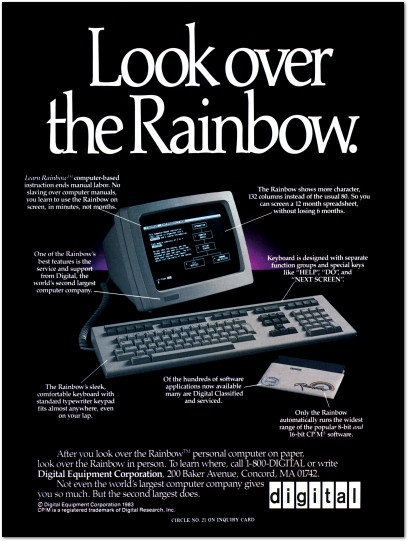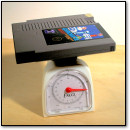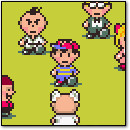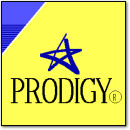[ Retro Scan of the Week ] The DEC Rainbow 100
March 8th, 2010 by Benj EdwardsIn the early 1980s, mainframe giant Digital Equipment Corporation (aka DEC for short) tried its hand in the personal computer market with the DEC Rainbow (1982). Since the market had not settled on an industry-wide PC standard at that time, DEC decided to support the two major operating system platforms of the day: Z80-based CP/M and 8088-based MS-DOS. The Rainbow contained both these processors and was capable of booting both OSes. Interestingly, despite the machine’s use of the 8088 and MS-DOS, the computer remained largely incompatible with the IBM PC from a hardware standpoint.
Discussion Topic of the Week: Imagine a world in which Digital Research CP/M, rather than MS-DOS, became the standard operating system for PCs worldwide in the 1980s. (That is, far beyond CP/M’s market share of the 1970s.) How might PCs today be different?







March 8th, 2010 at 6:47 pm
I’d think, hardware-wise, that computers would be quite different. The Z80 and compatable processors would hold a large market share, and most modern CPUs would be Z80 based.. Unless, of course, CP/M 86 or CP/M 68 would be big.. Intel’s market share would likely drop quite a bit.
Software-wise would be equally big. Likely, the modern OS would be based on GEM instead of Windows, plus Microsoft wouldn’t be quite as big.
March 9th, 2010 at 12:48 am
World with CP/M and Z-80 domination? There ARE modern 16- and 32-bit CPUs compatible with Z-80, so I can imagine this architecture instead of x86. Microsoft? Windows was based on DOS, but it could be based on CP/M as well IMHO, so in this matter world may look similar. Linux? Why not for Z-80 platform? Probably there is something like this (I know there are Linux based systems for MOS6502). But one thing may look diferent: European hardware market may be much more important. There were sir Sinclair, Amstrad/Schneider, most eastern-European countries had their own Z-80/CP/M computers. All this went down, but in the CP/M world they may gain importance and power.
Other scenario is neverending battle between CP/M and MS-DOS. That may change the world much more. Equally shared market leaves more room for another competitors (e.g. 68000: Atari ST, C= Amiga, Apple). I can imagine the world, where Motorola architecture gained domination…
March 9th, 2010 at 1:41 pm
My first paid IT job was with a client that had 8086 machines running Concurrent CP/M. This was back in 1989 or so. There was a token ring network, the machines had 5MB hard drives except the ‘file server’ which had 10MB!
It all worked perfectly, especially Concurrent CP/M. I could be typing away and the only reason I might notice that someone else was accessing my hard drive was because the disk activity light came on unexpectedly. I could set off 4 simultaneous CBasic compile jobs and go for lunch. They would all complete without conflicts on a purely cooperative basis.
Compare that with the horrendous shock I got when being exposed to MSDOS on an IBM PC for the first time. Network cards that completely froze the machine – even keystrokes not registering – whenever a file was read from the machine remotely, only to lurch back into life once the disk read was over.
In short, a world with CP/M would have got us to a place that is somewhat better than we are now about ten years sooner.
March 9th, 2010 at 3:12 pm
To ask how PCs might be different, you have to ask why CPM would have beaten MSDOS. It’s really not a technical question; it is a business and marketing question.
MSDOS was just a re-implementation of CPM for the 8088, and Digital Research had their own CPM-86. MSDOS was designed on purpose to be closely CPM compatible, so major CPM applications like WordStar, dBase, and AutoCAD could be ported with minimal effort. MSDOS 1.0 had only drive letters, and no subdirectories, and the APIs and data structures were close to identical.
The chips weren’t a big deal. CPM wasn’t written for the Z80, it was written for the 8080. The Z80 was a variant from Zilog on the 8080, and Intel had its own successor in the 8088 which was compatible with the 8080 memory model. So the transition to the 8088, then 8086 and further was inevitable.
I consider AppleSoft BASIC and Windows 1.0 to be the last truly original products from Microsoft; every other new major product from them has been an acquisition. So even if DR succeeded in getting CPM sold with IBM PCs, it still would only have been a matter of time until the Microsoft machine took over. Perhaps I’m just a little fatalistic.
There were a lot of fun things we could do then. I remember at one point around 1989 or 1990, doing multiasking with Excel plus Windows 2.0 runtime within one DesqView window, and MS Word 5.0 for DOS in another. I had GEM Draw in the somewhere too. What a pain! 🙂
March 9th, 2010 at 3:34 pm
I agree with the above poster, there’s still a ton of Z-80 out there. It’s almost better that it went underground-ish. It’s still pretty prolific. Maybe as we move further into small, low-power convergence devices Z-80 will prove to be a much longer-term contender.
March 9th, 2010 at 6:04 pm
Ah, the masterpieces I created with GEM Paint! Now being a Mac user, looking back GEM was a lot more ‘Mac-like’ than Windows, so it pleases me to imagine that if CP/M had taken off, we might have ended up with some pretty advanced computing environments, like OS X or Linux/Xwindows 10 years ahead of time, without all that mucking about with legacy Windows/DOS stuff. But what do I know? My computer lineage consists of Atari 800 (with a little school Commodore Pet on the side) -> 8086 with DOS and GEM Desktop -> Win 3.1/95/98/2k/XP and Linux -> OS X.
February 7th, 2011 at 2:15 am
I was waiting for someone to bring up DesqView (and QEMM)! I loved them more than anything in the world for so many years and was so productive with my old DOS based PC while other people were chugging along in the very early and very crappy and slow versions of Windows.
April 18th, 2011 at 4:36 pm
Maybe we don’t need to imagine what the world would have been like with CP/M and the Z80, but rather just wait for history to repeat itself on ink-jet printed electronic devices.
Right at this moment, printed electronics are rather simple, very similar to the original 8-bit personal computers of the 80’s. Roll-to-roll OLED displays are also on their infancy.
It’s just a matter of time before someone “recycles” CP/M, OS9 (or Flex) or any of the other OS’s at that time, to create milk carton “microcomputers” for targeted uses.
I think the very first systems will be advert style magazine flyers capable of tweeting (to a defined account). I envision an ad company using a “punch card” theme to replace the keyboard, which could be user punched by the “user” as novelty item, using the Commodore 64 tweet app.
Later on, we could see credit card sized web servers for WiFi and the, I guess, the inevitable cereal box gizmo.